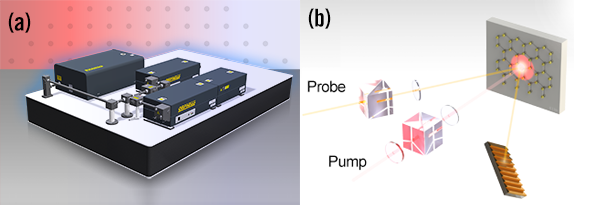-
Research
Our group explores novel quantum phenomena associated with light-matter interactions in low-dimensional condensed matter systems. When electrons and phonons are confined in nanometer or atomic scales, they exhibit distinct properties from those in the bulk, such as strong quantum confinement and enhanced many-body interactions. We aim to elucidate the nature and dynamics of these states by advanced frequency-resolved and time-resolved laser spectroscopy. See a colloquium overview by Professor Lui here.
-
Laser spectroscopy
Our group specializes in different types of frequency-resolved laser spectroscopy with spectral range from terahertz, infrared, visible to ultraviolet (wavelength 200 nm – 1 mm, photon energy 0.001 - 5 eV, Figure 1). For instance, we probe the electronic transitions in the materials by measuring their optical absorption, emission and photoconductivity through UV-Visible spectroscopy, Fourier transform infrared spectroscopy (FTIR), and time-domain terahertz spectroscopy. We also investigate their lattice vibrations by advanced Raman spectroscopy with frequency down to 5 cm-1.
-

Figure 1. The spectrum of electromagnetic radiation. Our laser spectroscopic techniques cover a broad range from terahertz to ultraviolet.
-
Ultrafast science
The second important aspect of our research is to understand the dynamics of condensed matter systems. Since the motion of electrons and nuclei in materials occurs on the femtosecond time scale, investigation of these dynamical processes requires sophisticated ultrafast and nonlinear optics. Our lab is equipped with state-of-the-art ultrafast lasers with extremely high time resolution (~10-13 s) and broadly tunable wavelengths (400 nm to 20 μm). These tools enable us to capture ultrafast processes by means of pump-probe spectroscopy (Figure 2). In addition, the high optical intensity of the laser allows us to exploit the nonlinear optical response of materials, such as second harmonic generation. We also use the laser to engineer material properties and realize novel quantum phases of matters.
-

Figure 2. (a) The ultrafast laser system in our lab, which consists of an amplifier (Pharos, 10W) with tunable repetition rate 1 - 600 kHz and two optical parametric amplifiers (Orpheus) with tunable wavelengths from 400 nm to 20 μm. (b) A schematic pump-probe experiment, in which a strong beam pumps the sample, generating a non-equilibrium state, and a weaker beam probes the pump-induced change in the reflectivity. Measurement of the reflection spectrum as a function of pump-probe time delay yields information about the relaxation of electronic states in the sample.
-
Innovative materials
Our current research focuses on the investigation of two-dimensional (2D) materials, such as graphene, boron nitride, transition-metal dichalcogenides and black phosphorus. These materials exhibit rich physics, such as strong interactions with light, emergent Dirac fermion phenomena, coupled spin-valley physics, and strongly-correlated states. Their flat and inert surfaces also enable us to produce heterogeneous stacks of different 2D crystals with atomically sharp interfaces (Figure 3). These features permit engineering of devices with unprecedented properties, which hold promise for the next-generation electronics. Given the plethora of 2D materials and potential heterostructures, we expect to identify many new physical phenomena and material properties.
-

Figure 3. A heterostructure device formed by a stack of monolayer MoS2, boron nitride and graphene. Vertical current with spin and valley polarization can be generated by optical excitation with circular polarization.

